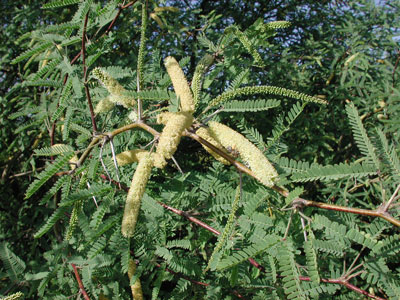Velvet Mesquite
Prosopis velutina

Photographed along Mesquite Wash, Maricopa Co., Arizona. April 2008.
Sponsored Links:
TREE: Usually a single-trunked tree, but sometimes grows as a large
shrub particularily when cut or fire damaged. Bark of older branches and trunk
is dark gray, with fissures. Where reliable water supply is present velvet
mesquite can grow to large proportions with a very broad crown.
LEAVES: Twice-compound leaves with usu. two or four sub-rachises each
with numerous small leaflets. Young leaves set with fine pubescence. Leaves, as
in many legumes, fold up at night.
RANGE: Normally mesquite is most abundant along the drier margins of
riparian corridors where the water table is some meters below the surface.
Where sand a gravel bars are piled high between channels mesquite trees will also flourish
within sycamore woodlands. Generally scarce above 1800 meters elevation.
FRUIT: Elongate beans slightly constricted between each bean-seed. Very
sweet to taste when ripe - i.e. reddish-yellow in color. Later changing to
yellow-brown.
FLOWERS: Spikes of numerous, small yellow-cream flowers. The petals are
nearly rudimentary - instead flower color is the result of long, colored
stamens.
ARMED. Generally has sturdy, straight thorns, two per node. There is
considerable variation in the length of thorns. Even within the same plant some
branches, particularily those in direct, hot, sunshine, have much longer,
sharper thorns.
Read
more on Sonoran Desert Naturalist